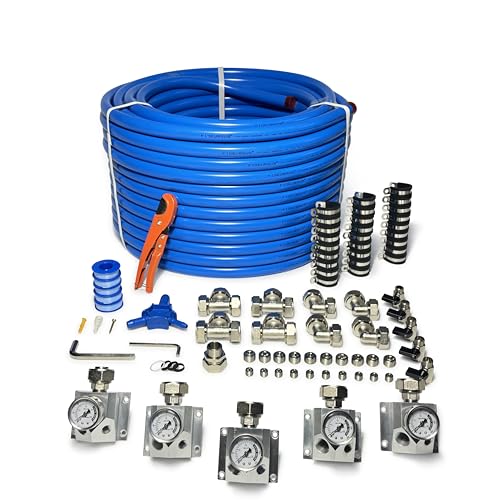Ever heard a sudden hiss of escaping air and then watched your air compressor lose power? That frustrating moment often points to a problem in your air lines. Choosing the right pipe for your air compressor is more important than you think! A bad choice can lead to leaks, wasted energy, and even damage to your tools or compressor.
Picking the right pipe can be tricky. There are many types, like copper, PVC, and steel. Each one has different costs, strengths, and weaknesses. Many people get confused by all the choices and end up with a system that doesn’t work well. This can lead to costly repairs and downtime. It’s also important to pick a pipe that is safe and can handle the pressure of your air compressor.
This blog post will help you become an air line expert! You’ll learn about the different types of pipes and their pros and cons. We’ll also cover important factors like pressure ratings and installation tips. By the end, you’ll be able to choose the perfect pipe for your air compressor system. Get ready to build an efficient and reliable air system!
Our Top 5 Pipe For Air Compressor Lines Recommendations at a Glance
Top 5 Pipe For Air Compressor Lines Detailed Reviews
1. WYNNsky Shop Air Line Kit
Rating: 8.7/10
The WYNNsky Shop Air Line Kit is built for serious air tool users. It’s great for home garages and shops. This kit has everything you need for long air line runs. You get a 60-foot nylon air pipe. It also comes with connectors, a cutter, and mounting clips. This gives you the power to set up your air system the way you want!
What We Like:
- The 3/8 inch nylon tubing is strong and won’t rust.
- It can handle up to 200 PSI of pressure.
- The kit includes a cutter to prepare the tubing.
- You get many different connectors to build your air line.
- It is designed for high-demand air tool users.
- You can design your own air system.
What Could Be Improved:
- You must assemble the tubing and connectors carefully.
- You might need to use seal tape on the metal fittings.
The WYNNsky Shop Air Line Kit is a solid choice for anyone needing a reliable air system. It provides a lot of flexibility for different shop setups.
2. Compressed Air Piping System
Rating: 9.4/10
Tired of tangled air hoses and limited reach in your shop or garage? This Compressed Air Piping System offers a complete solution. It includes everything you need to set up a reliable and efficient compressed air system. The kit features 200 feet of 3/4-inch black HDPE pipe, aluminum wall outlet blocks, fittings, and essential accessories. It’s designed for easy installation and long-lasting performance. You can easily upgrade your workspace with this kit.
What We Like:
- The kit includes all the parts you need.
- The pipe is strong and resists damage and corrosion.
- Installation is easy. You don’t need to cut, thread, or glue the pipe.
- It works well in many different shop and garage layouts.
- The fittings have a good seal.
What Could Be Improved:
- The included instructions could be clearer.
- More detailed diagrams could help with installation.
This air line kit is a great way to improve your shop or garage. It makes working with compressed air easier and more efficient. Get yours today!
3. Compressed Air Piping System with 3/4 Inch ID x 200 feet 5-Way Multi-Outlet Aluminum Manifolds with Indivdual Pressure Gauge HDPE Tubing Shop Air Line Kit
Rating: 8.7/10
The FIDEURSUS Compressed Air Piping System is a complete kit to get your shop or garage set up with compressed air. This kit includes 200 feet of flexible HDPE tubing, a 5-way manifold with pressure gauges, and all the fittings you need. It’s designed for easy installation and is built to last. This system delivers clean air and is perfect for various tools and equipment.
What We Like:
- The three-layer HDPE pipe is strong and leak-proof.
- The flexible pipe is easy to bend and install in different layouts.
- The system has multiple port sizes for various tools.
- It is rust-free and efficient.
- Installation is simple and does not require glue or welding.
- It is adaptable to many settings, like shops and garages.
- Customer service is available 24/7.
What Could Be Improved:
- No cons mentioned.
This air line kit is a great way to set up a compressed air system in your shop. The flexibility, durability, and ease of installation make it a good choice for both beginners and experienced users.
4. Shop Air Line Kit Compressed Air Piping System 1/2″×150’&260′ HDPE Air Tubing Air Compressor Accessories
Rating: 9.2/10
The Shop Air Line Kit is a complete system for your air compressor. It includes everything you need to set up a compressed air piping system in your shop or garage. The kit features durable HDPE tubing, fittings, and all the accessories you need for easy installation. This allows you to distribute compressed air throughout your workspace efficiently.
What We Like:
- Sturdy and long-lasting. The HDPE-Aluminum-HDPE tubing resists corrosion. It can handle high pressure.
- Comes with everything you need. The kit includes all the fittings, clips, and tools. You won’t need to buy extra parts.
- Easy to install. You don’t need glue, soldering, or crimping. Just use a screwdriver and wrenches.
- No Leaks! The O-ring compression style fittings create a tight seal. This prevents air leaks.
- Works in different spaces. You can install the tubing in the wall or on the ceiling.
What Could Be Improved:
- The provided instructions could be more detailed.
- Consider offering different kit sizes for smaller shops.
This Shop Air Line Kit is a great choice for anyone needing a compressed air system. It’s easy to set up and will provide reliable air for your tools.
5. Shop Air Line Kit 3/4″100’&200’&300′ HDPE-Aluminum-HDPE Air Tubing Kit for Compressor Accessories
Rating: 9.0/10
Need a reliable air system for your garage or shop? This Shop Air Line Kit is the answer! It’s a complete kit with everything you need. This kit uses strong, leak-proof tubing. It’s designed to work with air compressors and accessories. It comes in different lengths, like 100′, 200′, and 300′. You can set it up quickly and easily. Get ready to power your tools with this fantastic air line kit!
What We Like:
- The tubing is made with three layers. This makes it strong and resistant to leaks.
- It comes with all the parts you need. You don’t have to buy extra pieces.
- Installation is easy. You only need a few basic tools.
- You can use it in many different places. It works well in garages, shops, and factories.
- It’s safe. The tubing can handle high pressure.
What Could Be Improved:
- More information about the long-term durability of the fittings.
- Clearer instructions on how to customize the kit for different shop layouts.
This Shop Air Line Kit is a great option for anyone who needs a reliable air system. It’s easy to install and built to last. You’ll be happy with this air line kit!
The Ultimate Guide to Buying Air Compressor Lines
Getting the right air compressor lines is important. They move air from your compressor to your tools. This guide helps you choose the best ones for your needs.
Key Features to Look For
You should look for some key things when buying air compressor lines.
- Length: Think about how far you need the air to travel. Measure the distance from your compressor to where you’ll be working. Buy a line that is long enough. You can always get a longer one and coil up the extra.
- Diameter: The diameter is the size of the hole inside the hose. A larger diameter lets more air flow. This is important for tools that need a lot of air. Small tools like nail guns might work fine with a smaller diameter.
- Fittings: Check the fittings. These are the connectors that attach the hose to your compressor and tools. Make sure they fit your equipment. Quick-connect fittings are easy to use.
- Pressure Rating: All hoses have a pressure rating. This tells you the maximum air pressure the hose can handle. Always choose a hose that can handle more pressure than your compressor produces. This is a safety step.
- Flexibility: A flexible hose is easier to move around. It won’t kink as easily.
Important Materials
The material of the air compressor line matters. Here are the most common choices:
- Rubber: Rubber hoses are flexible and durable. They are good for many jobs. They handle rough use well.
- Polyurethane (PU): PU hoses are lightweight and flexible. They resist kinking. They are good in cold weather.
- PVC (Polyvinyl Chloride): PVC hoses are a cheaper option. They are not as flexible as rubber or PU. They can crack in cold weather.
- Hybrid: Some hoses use a mix of materials. They combine the best features of rubber and PU.
Factors That Improve or Reduce Quality
Some things make air compressor lines better or worse.
- Quality of Materials: Higher-quality materials last longer. They can handle more pressure. They are less likely to leak.
- Construction: How the hose is made affects its quality. Good construction means the hose won’t crack or separate easily.
- Reinforcement: Some hoses have reinforcement layers. These layers make the hose stronger. They help it resist pressure and wear.
- Brand Reputation: Buy from a trusted brand. They usually make better products.
- Price: Price can show quality. Don’t always choose the cheapest option.
User Experience and Use Cases
Air compressor lines are used for many tasks.
- DIY Projects: You can use them for painting, inflating tires, and powering nail guns.
- Automotive Repair: Mechanics use them to run impact wrenches and other tools.
- Construction: Construction workers use them for pneumatic tools.
- Industrial Applications: Factories use them for various equipment.
Good air compressor lines make work easier. They help you get the job done safely.
Frequently Asked Questions
Q: What is the best material for air compressor lines?
A: Rubber and polyurethane are great choices. They are durable and flexible.
Q: How do I choose the right length of hose?
A: Measure the distance from your compressor to your tools. Add some extra length just in case.
Q: What is the importance of hose diameter?
A: A larger diameter allows more air to flow. This is good for tools that need a lot of power.
Q: What are quick-connect fittings?
A: Quick-connect fittings make it easy to attach and detach tools.
Q: Why is pressure rating important?
A: The pressure rating tells you how much pressure the hose can handle. Always choose a hose with a higher rating than your compressor.
Q: Can I use any type of air compressor hose?
A: No, you need a hose designed for air compressors. This is for safety reasons.
Q: How do I store my air compressor hose?
A: Coil the hose neatly. Store it in a cool, dry place. Avoid direct sunlight.
Q: What if my hose gets a leak?
A: Stop using the hose immediately. Replace it with a new one.
Q: How often should I check my air compressor hose?
A: Check your hose before each use. Look for cracks, leaks, or wear.
Q: Where can I buy air compressor lines?
A: You can buy them at hardware stores, auto parts stores, and online.
In conclusion, every product has unique features and benefits. We hope this review helps you decide if it meets your needs. An informed choice ensures the best experience.
If you have any questions or feedback, please share them in the comments. Your input helps everyone. Thank you for reading.

Hi, I’m Tom Scalisi, and welcome to The Saw Blog! I started this blog to share my hands-on experience and insights about woodworking tools—especially saws and saw blades. Over the years, I’ve had the chance to work with a wide range of tools, and I’m here to help both professionals and hobbyists make informed decisions when it comes to selecting and using their equipment. Whether you’re looking for in-depth reviews, tips, or just advice on how to get the best performance out of your tools, you’ll find it here. I’m excited to be part of your woodworking journey!





